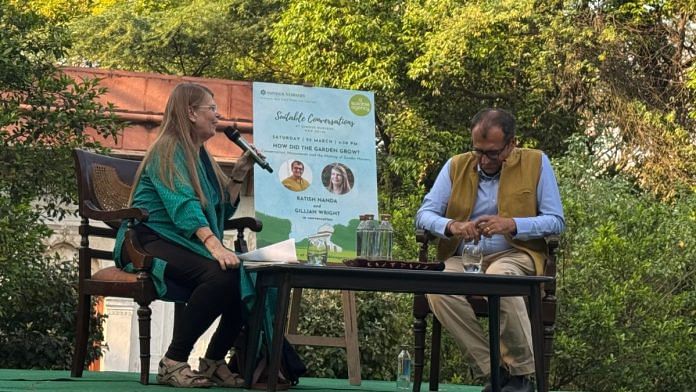New Delhi: In the last few years, Sunder Nursery has emerged as a popular getaway for Delhi’s residents—a quiet escape from the Capital’s everyday frenzy. But hardly anyone knows about the garden’s history and its revival.
From a forgotten Mughal-era garden to a sprawling nursery and heritage park to now the city’s beloved garden.
In a discussion, titled How Did The Garden Grow?: Conservation, Monuments and the Making of Sunder Nursery, conservation architect Ratish Nanda and writer-translator Gillian Wright traced the journey of this heritage park.
A 16th-century heritage park abutting Humayun’s Tomb, Sunder Nursery was formerly known as Bagh-e-Azeem. The Aga Khan Trust for Culture (AKTC) and Ratish Nanda are credited with restoring both the sites.
“It’s lovely to be here. The only venue in Delhi where you can be upstaged by peacocks,” Wright said, in her opening remarks, at Sunder Nursery on 22 March.
And she wasn’t wrong. During the hour-and-a-half discussion, peacocks rumbled in the distance, chirping birds filled the air, and trees shed their golden leaves over the audience. The discussion took place on a makeshift stage that was set up at the centre of the Mughal Pavilion area. A dozen chairs were placed around it along with a green carpet scattered with colorful pillows for people to sit on the ground.
“The first post-independence avatar of the nursery was some 75 years ago. There were hardly any trees and also, no zoo,” said Wright, as Nanda nodded.
Before moving to Nanda to discuss the restoration of the heritage park, Wright spoke about Sunder Nursery’s history, including its early mentions, and how it was eventually lost in the wilderness.
It was in the 1940s, Wright said, when British horticulturist Alick Percy-Lancaster first mentioned Sunder Nursery in his book. “Back then, Sunder Nursery was an open-air laboratory. And Lancaster experimented with seed potatoes here, storing them from one season to the next. The nursery even supplied flowers for weddings and even vegetables were also sold from here,” said Wright.
Wright added that Lancaster was the last British horticulturist in India to oversee the upkeep of the nursery. And after him, the nursery went into a “sleepy place for decades.”
The agreement
It was an agreement with the AKTC that led to the transformation of the nursery. In 2004, then-prime minister Manmohan Singh met the Aga Khan in Delhi and invited the Trust to work in the field of culture through a public-private partnership model.
Three years later, the AKTC signed an agreement with the ASI, the MCD, and the Central Public Works Department, for Sunder Nursery’s restoration, Nanda recalled.
The monuments were rediscovered with their roofs gone and most of its structure rundown. However, Nanda and his team immediately began the restoration within 10 hours of signing the MoU, using their own money and resources.
“You must be wondering—what was the hurry? The hurry was that the monuments were on the verge of being demolished. There was a proposal for a highway 70 metres wide—right through Sunder Nursery,” the architect said, as Wright looked at him in astonishment.
And since it was a ruin, “it was considered easier to be demolished,” Nanda went on to say.
As Wright began to respond, she was forced to stop by the incessant chirping. She then raised her hand and greeted them with “Salaam! Salaam! Salaam!”
It was the arched monument behind the stage that would have also been demolished for the highway project, Nanda said, pointing at the structure.
“The destruction of around 5,000 trees along the route was imminent. Not just that, at least four or five major monuments, including this one, would have been demolished,” he said. Just then, a peacock peeked out from the structure’s terrace.
Also read: This professor wanted to translate ‘A Passage to India’ to Hindi. King’s College rudely denied
Something for everyone
Sunder Nursery has something for everyone, said Wright. As the discussion progressed, the question of the garden’s landscape and accessibility emerged. Wright called it “the highest quality of landscape accessible to everybody.”
Nanda credited his colleagues for that. “The effort they’ve put in over the years has ensured that the site is managed and maintained the way it was designed,” he said.
That’s when Wright told the audience that her partner moves around the nursery in a wheelchair.
“And I think that this is one of the few places in Delhi where there is proper wheelchair accessibility. And you can get to most parts of the park in a wheelchair,” she said.
As the discussion came to a close, a couple, not part of the audience, ran after a peacock to take a picture. Wright and Nanda paused briefly, asking the couple to leave the bird alone.
“Stop it! Leave the bird alone, please,” said Nanda.
The peacock, terrified by the chasing, had started trotting before quickly spreading its wings and flying away.
(Edited by Aamaan Alam Khan)







Invaders Muslim terorrists Mughals was the biggest Anti Hindus enimise of Hindus,they ruined everything in bharat, destroyed hindus temples, culture, tradition, rituals,heritages,looted all, converted most of the Hindus,but Anti Hindu uneducated Muslim Nehru khazi and his Madurassa educated illiterate Abdul Kalam Azad glorified all Anti Hindu Muslim rules invaders, manipulated bharth history, Hindus kings are projected in bad lights, everything thing for Muslims even overlooking religious base partition,two nation theory,made Hindu share hindustan too for Muslims,all roads renamed to honour Anti Hindu Muslim invader’s, continued till the end of Muslim khagrass rules at the centre,RSS BJP govt should remove all Anti Hindu Muslim names from hindustan including their memorials immediately,some Anti Hindus will say it’s all historical importance shits to appease Anti Hindu Muslims inside the country, ignore all remove, demolish all.jai Hindu unity.
Can anyone think of Delhi without the Muslims and the Mughals, in a positive light. So deeply embedded in the city’s culture. And those of us whose roots lie in Old Delhi, even more so.